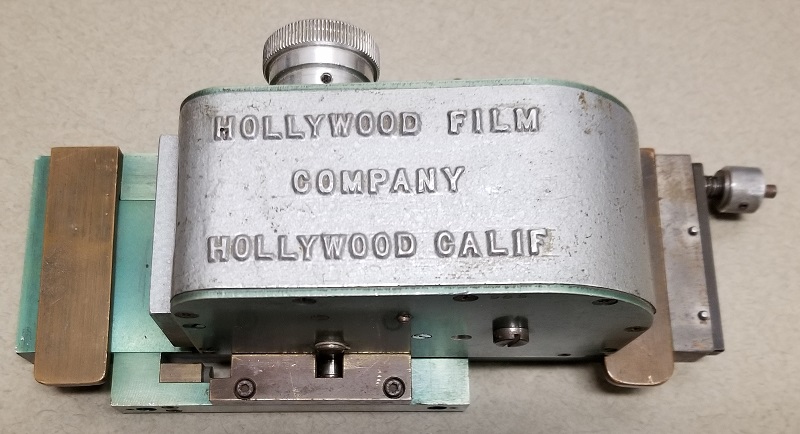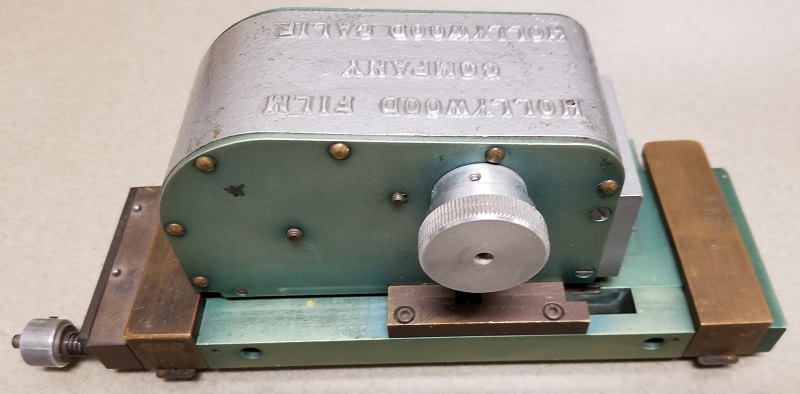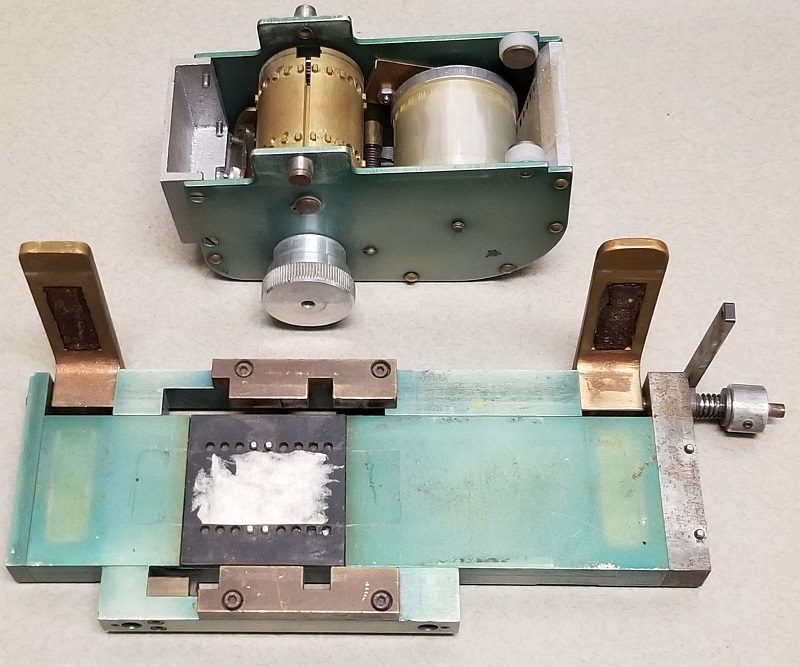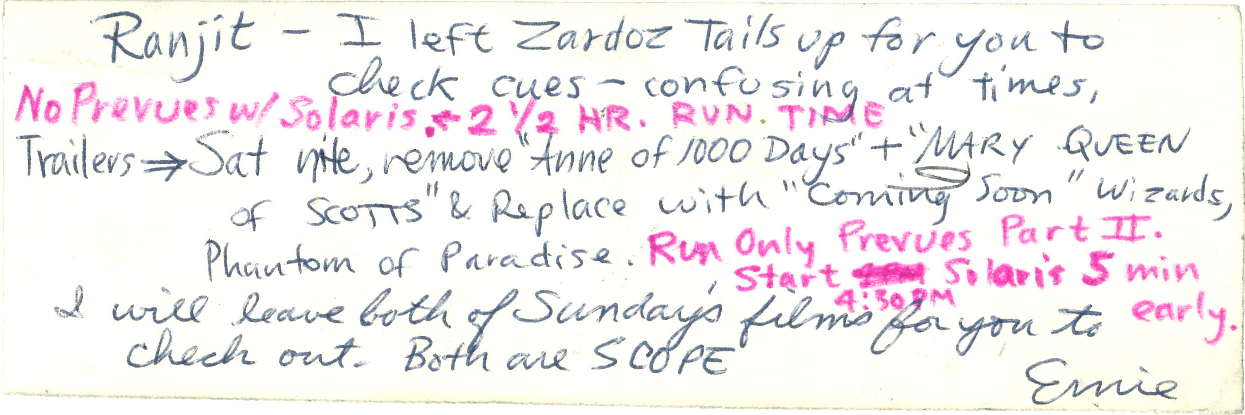Chapter 22
Vandalizing the Films
Vandalizing the Films
Mark seemed to be slipping, and the prints he had inspected now had mistakes.
From the day it happened until today, it never crossed my mind that Saturday, 29 April 1978, was planned,
but now that I am going over the events of that day and the following days, I am convinced that it was indeed planned.
It was on that Saturday that we presented
New York, New York and
Cabaret.
New York, New York had just been abridged by about 30 minutes, and so our showtimes were a mess.
There was an intermission of a little over half an hour before Cabaret.
I was alone in the booth for New York, New York, but then, just before Cabaret, Ernie showed up,
together with either Mark or the manager or the assistant manager. I do not remember which.
I started Cabaret and poked my head out the little door to monitor picture and sound,
when suddenly the film jammed and a frame melted on screen.
It was the first time in my life I had ever seen a film jam and melt.
It took me a few seconds to figure out what I had just witnessed.
Ernie was pulling the film out of the projector to splice it and get the show back on the road.
Apparently, the opening of Cabaret had been shredded.
I’m pretty sure it was Mark who had inspected that print, though it may have been Ernie.
I don’t remember for sure after all these years.
I wrote off the event as a one-time mistake, but then something happened the next day, too.
At the start of the matinée shift on Sunday, 30 April, for a double feature of
Murder Ahoy and
Murder Most Foul,
I hit the screen out of frame.
There was a huge black bar on the top of the screen.
I could hardly believe it.
I wanted to see if this was an anomaly, or if I should adjust the framing,
but I waited maybe four or five seconds to be sure.
It was a mistake to have waited even a quarter of a second.
I adjusted the framing.
As I was doing that, I heard steps pounding up the little spiral staircase.
There he was, the Second Business Partner, complaining that the image was out of frame.
He was high-strung and impatient, and his voice was cold.
“I fixed it,” I said.
With every muscle tensed, he crouched down to peer out the porthole window, and peered again, and again,
and then dashed away, without saying another word.
I got a really bad vibe from him.
I doubt he was there to enjoy the movie.
He didn’t seem to be the type to enjoy a quirky, laid-back British comedy.
He was there only to catch my mistakes, I’m certain.
Why is it that, exactly at the two moments of my first two apparent blunders
(both of which were the fault of the person who inspected the prints, who I am pretty sure was Mark),
my bosses had just shown up to witness the on-screen mistakes?
The break in Cabaret had been a test, a test I was meant to fail.
Now that I think about it, that misframed splice in the leader of Reel 1 of Murder Ahoy was also a test, and I was meant to fail that test as well.
I was eventually blamed for both.
That was the beginning of the decline.
With the sole exception of The American Friend, all future prints were vandalized.
Maybe they didn’t rip up The American Friend because lead actor Bruno Ganz looked a little bit like the owner of Movie, Inc.?
Just a guess.
|
Oh. I should mention something else.
Ernie had left me the new previews to assemble onto the preview reel,
and so I just spliced them on, routinely, without giving it much thought.
When I played the previews before the first film,
I realized, “Oops! I think we made a mistake!”
One of the previews was for The Story of O,
which was not the sort of preview to run with a family film that probably had little kids in the audience.
Oops.
I can’t find that preview online.
It was a series of still images, the camera pulling out on each one, as a woman narrated in English.
Yes, there were naughty bits on the film, but all those naughty bits were cropped out at 1:1.66. Phew!
|
Oh, wait! There was one other print that was not vandalized, and I know exactly why it was not vandalized.
A women’s group booked a special members-only screening of
One Sings, the Other Doesn’t
on a Saturday morning before the regular matinée.
(If you search the online newspapers, you will find
a different booking for a different women’s group on a weekday evening.
I never knew about that before. There is no mention I can find of the Saturday special screening, but, yes, it happened.)
Mark was brought in to run that show, because nobody trusted me with it.
Surely, because it was a special booking, Mark was required to keep his eyes on the screen at all times,
and thus had not a moment to rip up the film when he had the reels on the rewinder.
As the special screening was letting out, I came in and relieved Mark to run the regular matinée show.
I overheard the new assistant manager (wish I could remember his name!) chatting for a moment with someone from the private audience,
agreeing with her: “Yeah, it got me really choked up.”
So, I came in and ran the regular matinée show, and all was fine.
Of course, I was too busy doing a hundred other things and was unable to watch the movie,
but the warm feelings it had engendered among the crowd at the specialty screening got me interested.
I managed to catch a few glimpses, and I was appalled.
I do not, have never, shall never enjoy searching-for-my-identity stories,
nor do I, nor have I ever, nor shall I ever enjoy stories about insecure people.
From what little I saw, that’s all this movie was.
Or, maybe, was it just simply that my interpretation had been colored by the insult?
Yes, I was truly insulted that nobody trusted me to run a movie for a special screening.
That was further evidence that this job would be short-lived.
I did not yet realize just how short-lived it would prove to be.
As soon as I began my employ, I decided to make change-overs manually, to avoid that horrid, deafening static,
and that’s why the other projectionists deliberately miscued the reels,
blotting out correct cues with black varnish, and scratching in new cues, so that I would bungle those change-overs .
They also lengthened leaders, which made the problem worse.
Could I have solved or reduced the problem by turning on the automation to sense the foil cues?
No, because there were no foil cues on those prints.
It was for Bananas
that Mark left me a note, telling me that there were three cues at the end of a reel,
and warning me not to use the first cue, which was a false cue, but to wait for the second.
I did so — and totally blew the change-over.
The first cue was right. The second cue was false.
That got reported to the head office.
|
We had a triple feature that day:
Take the Money and Run,
Bananas, and
Love and Death.
Bob Shaffer had told me, if you will recall, that he had treated a print of Bananas with Vitafilm
and had thus gotten purple splotches all over it.
He had misremembered.
He had treated Take the Money and Run with Vitafilm, because that’s the print that had purple splotches all over it.
Bananas was in much worse shape.
I hastily and sloppily scribbled down a copy of Ernie’s minimalist film-inspection report.
He had counted 156 splices in that print, and in the column to indicate how many splices he

|
You see, after my first few weeks, something new had started happening:
On the night before my shift, the films suddenly, magically filled themselves with misframed splices,
and the misframed splices were all fresh, brand-new Hollywood Film Company 8-perf splices.
Every one of them. Every last one of them.
Donald Pancho’s was the only cinema in the exchange region that had a Hollywood Film Company 8-perf splicer.
Now that I detected the pattern of vandalization, I wanted to arrive early (on my own time) to inspect the prints and make repairs,
but I was never given a key and I was never permitted in the building until immediately before showtime.
I think I was the only employee without a key.
|
ANOTHER BORING SIDE NOTE.
Other cinemas in that exchange region had

So, here we go.
The blade, on the very right, is missing its handle.

This is the reverse view.

We lift off the top piece.
I turned it upside-down so that you can see the inner workings.
When we turn the knob as far as it will go, it will bring down enough perforated tape to cover exactly two frames,
and at the end of the rotation, a VERY SHARP blade will engage, slide into the groove in the brass wheel, and cut the tape to size.
When we turn the knob back, the blade retracts.
We lay the film down in the lower piece, in the path, and align the sprocket holes with the registration pins.
The two frames that will be covered by tape rest on a rubber cushion.
For an apparently needless nonreason, somebody glued a paper label to the rubber cushion,
and I shall not enjoy the process of cleaning it off.
Once the film is comfortably aligned, we drop the two brass handles to hold the film in place.
We place the top piece back, and its two pins readily and effortlessly fall into the slots in the rails that are plainly visible.

We then gently roll the top piece to the left and lift it out once it has reached the end of the rails.
The problem with this eBay hand-me-down is that it takes rather some force to get the top piece back in,
and then it binds and will not travel down the rails.
Someone must have dropped it or dropped something on top of it, bending the base imperceptibly.
I have played with it a bit, but I cannot see where the problems are.
I abandoned all my tools twenty years ago, when the police convinced me to leave town and never return.
I had no time to sell anything and no money to transport it.
I just tossed half my belongings into a dumpster.
To repair this contraption, I would need to buy new tools, which I am in just no mood to do.
Yet I shall, someday, maybe this month, maybe this year, maybe this decade.
I shall.
I don’t know why, but I shall.
Or maybe I’ll just hire a machinist who enjoys tinkering and would charge me a reasonable rate to spend a weekend on this gadget.
Once I get it working again, I’ll make a little video showing it in action.
Won’t that be fun?
But please don’t hold your breath.
|


Bizarre note. I always labeled the leaders. I never had trouble seeing the cues.
It is not until now, in late 2021, as I read this again, that I see that this note was a set up.
This note alleged, in writing, that I vandalized leaders and missed cues.
This note was not submitted to HQ, but some similar communication surely was submitted.
Because we were changing programs every two days or so, we decided usually to run on 2,000' reels,
so as not to waste time with build-up and break-down.
As I was running the current double feature, I was also inspecting and mounting the next day’s double feature,
and, sweating bullets, I would anxiously turn around at the sound of every splice and imperfection and squat down to look through the porthole windows
to see what had gone wrong that time.
I slipped pieces of scratch paper into the take-up reel every time a bad splice or other damage went by.
Once each 2,000' reel came to an end, it was filled with lots of little pieces of scratch paper.
Also, there was the added enjoyment of discovering that the previous projectionist had ripped out the sprocket holes of about five or ten frames,
on both sides of the film, seemingly with a small screwdriver, just so that the film would break on me.
By some stroke of luck, on that day I had a few minutes to run through the beginning of a reel on the inspection bench,
and some little birdie whispered in my ear that I might as well check as much as I could, just in case.
That’s how I caught that damage and cut it out. Phew. Close call!
In between my inspecting the 12 reels of the next day’s films,
I had to put the 12 reels of the current day’s vandalized films onto the inspection bench so that I could repair the other projectionists’ damage,
working at quadruple speed, with my pulse racing.
I determined that it was usually (always?) Mark who had vandalized the films.
The managers would see that the previous double feature was fine (the show I had inspected),
and that the next show was fine (the show I had repaired),
and that the next day’s show was fine (the show I had inspected),
but that during my shift everything under the sun went wrong.
It never occurred to the managers to think this through.
They should have checked to see who had inspected which movies, and when.
They would have learned that the films I inspected played perfectly.
They should have also noticed that I was never permitted to inspect the films I was scheduled to run.
That was a mean low-down dirty-rotten game they played.
Even if it was only Mark who was guilty of the vandalism,
I cannot hold the managers and Ernie blameless,
because they deliberately chose not to give me a key,
and there could have been only one reason for that.
Ah! Another memory comes back.
We ran a double feature of Animal Crackers and
Duck Soup.
My memory is that Animal Crackers was mounted onto a pair of 6,000' reels, and that Duck Soup remained on 2,000' reels.
The second half of Animal Crackers had a leader that was several feet too long.
I normally laced up four frames before the ten-foot mark, which resulted in a perfect change-over,
provided that the ten-foot mark were correctly labeled,
and provided that the cues on the previous reel were exactly eleven feet apart.
Well, on this one leader, the ten-foot mark was actually about fourteen feet from the first image.
So I got a few seconds of black leader on screen.
Then the reels in Duck Soup had cues that were much less than eleven feet apart,
and so, again, I got black leader on screen.
Now, had I known, I would have compensated.
Had I known that the ten-foot mark was fourteen feet from the beginning,
I would have advanced the leader another four feet.
Had I known that a particular reel had cues that were only, say, nine feet apart,
I would have compensated by advancing the next leader another two feet.
There was no message about any such anomalies.
So I bungled every change-over.
Fortunately, on that Sunday matinée, I could watch the movies, because there was no double feature to mount for the following day.
Watch them I did, and I needed to, because the cropping was horrible, and I needed to follow the action by framing up and down all the way through.
That was impossible during the hat routine at the lemonade stand,
because some hats were on people’s heads right at the top of the frame,
and other hats were on the sidewalk right at the bottom of the screen — at the same time!
I did the best I could to give the audience some idea of what was happening during that scene.
Because I was watching the movies, I had no time to make any repairs.
So, when Mark came in to relieve me, I pointed out all the mistakes, and asked him to fix them.
Sure, no problem, he said; he promised he would fix them.
I returned on Tuesday evening, for the final showing of that double feature,
and I was working like mad to put Wednesday’s double feature together.
Mark had not made a single repair, and so I bungled all the change-overs all over again.
There was nothing I could do about that, because I did not have a list of precisely what was wrong with each reel.
Management noticed.
How did Mark run the show?
I have no doubt that he ran the leaders completely down to the first frame of film.
As soon as he saw the first cue, he hit the motor, the dowser, and then the picture and sound,
and one second later he was on the next reel.
He thus skipped significant amounts of film at each reel change.
(The regular projectionist at the Lobo did exactly the same.)
Nobody ever complains about five or ten missing seconds, no matter how obvious the deletion is, no matter how significant the material is.
Everybody complains about a split-second of black, though.
Mark was so meek, so mild, so gentle that no one would ever think he could possibly have a speck of malice.
I can’t even think of his surname after all these years.
I thought I had it written down somewhere, but I didn’t. Drat!
I learned a great deal about guys who are so meek, so mild, so gentle that no one would ever think they could possibly have a speck of malice.
They are now my prime suspects.
I made several mistakes, as I see from checking my notes, which I just pulled out of decades-long storage.
My heavens! According to my notes, there was even a time when I neglected to latch the take-up reel to the machine,
which caused the reel to fall off and irreparably damage 8 frames of film.
I have zero memory of that, but, ouch!, that’s a terrible mistake!
(I was so grateful, in later years, to run booths that still had magazines encasing the reels.
With such an arrangement, it was simply impossible to forget to latch a reel.)
The only mistake I do remember, without prompting from my old notes,
is the one that made me feel really dumb.
Because it was dumb. Really dumb. Superdumb.
I was running
What’s New, Pussycat? and thought that,
like all Woody Allen movies, it was five reels.
So I was getting close to the end of reel five, and it didn’t seem like the story was about to wrap up.
I looked at the film cabinet and I saw the leader for reel six dangling out.
My heart stopped.
I pulled off the first reel of the second feature as quickly as I could
and I started lacing up reel six, but not in time.
I was off screen for maybe five or ten seconds.
(No. My memory was lying to me.
I found my notes.
I actually did lace up the reel in time to make the change-over, but I had neglected to strike the arc.
So, while the sound was continuous, the screen was empty for two or three seconds until the light came on again.)
Yes, it was a Woody Allen movie, but he did not direct or edit it, and so it was six reels.
Why had I not noticed?
Oh well. That was a once. I think we are all entitled to a once.
Marvelous movie, anyway. Very funny.
Looking through my notes, I see that I also kept records of the mistakes that were not mine
but that showed on screen during my shifts.
Many were caused by vandalized prints.
Others had a different explanation.
You see, occasionally a different projectionist would enter the booth to lend a helping hand
or to train a new recruit (my replacement, as I had suspected), and they goofed during my shifts,
and their goofs were reported to HQ as being my goofs.
Egad! Gobs and gobs and gobs and gobs of horrid mistakes.
Text: Copyright © 2019–2021, Ranjit Sandhu.
Images: Various copyrights, but reproduction here should qualify as fair use.
If you own any of these images, please contact me.
Images: Various copyrights, but reproduction here should qualify as fair use.
If you own any of these images, please contact me.